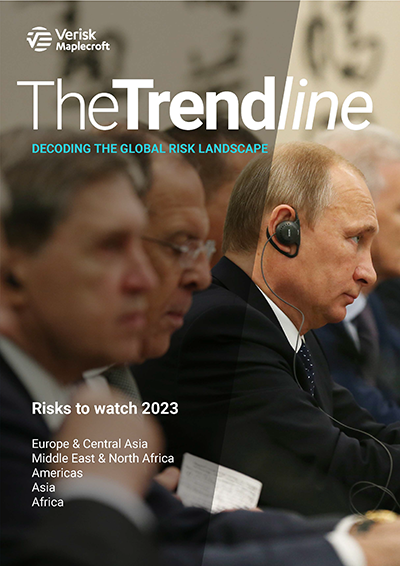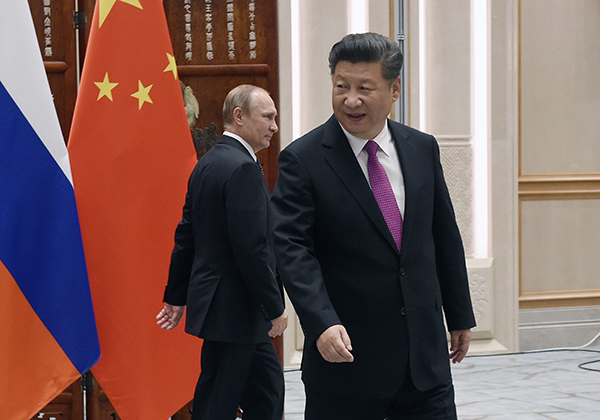The Trendline - Middle East & North Africa: Risks to watch
by Torbjorn Soltvedt and Hamish Kinnear and Eileen Gavin,
Corporates, investors and insurers working across the Middle East & North Africa will have plenty to deal with on the risk management front in the months ahead. These are our top 5 trends to watch in 2023: The determination of Turkey’s president Recep Erdoğan to secure re-election; the risk of disruption linked to energy and shipping infrastructure; the prospect of economic reforms triggering social unrest; Iran’s collision course with the US and Israel; and the difficulties ESG investors face when engaging with the region’s plutocratic leaders.
Erdoğan will stop at nothing to secure re-election
Despite this week’s devastating earthquake, Recep Tayyip Erdoğan is likely to win Turkey’s crunch presidential election this year. Public anger over corruption and poorly enforced building regulations, which may have played a role in the extent of destruction, could be weaponised by the opposition. But Erdoğan’s declaration of a 90-day state of emergency gives the government wide latitude to boost public spending and silence criticism – he could yet win back control of the narrative.
The polls were already unlikely to be free and fair: Turkey is categorised as high risk in the 2023-01 version of our Democratic Governance Index. Indeed, the opposition already faces legal roadblocks. Key Erdoğan rival and mayor of Istanbul Ekrem Imamoğlu was sentenced to a prison term for “insulting” a court in December 2022 and may be barred from politics if his appeal fails. Elsewhere, Erdoğan’s AKP government is juicing the economy to win support – most notably by boosting the minimum wage by 55% – and issuing threats against Greece and Kurdish armed groups to shore up its nationalist base.
A victorious Erdoğan would double down on his unorthodox economic (mis)management – keeping inflation and borrowing costs painfully high, which will, in turn, create difficulties for foreign firms on the ground. Turkey’s assertive foreign policy stance, so often a headache for the EU and NATO, is also likely here to stay.
Energy infrastructure and shipping in the firing line
Oil and gas importers looked to the Middle East last year in hope of increased supply to bring down energy prices. Despite plans in Saudi Arabia, the UAE and Qatar to boost production capacity, the region will not offer any quick fixes for the global energy crunch in 2023.
Competition for supply will be fierce. More pressingly, the risk of disruption is rising. As nuclear talks between the US and Iran are abandoned in all but name, attacks against shipping and energy infrastructure in and around the Persian Gulf are set to intensify.
Attacks by Iran-backed groups in the region – shown in the map below – proved manageable during the last major wave in 2019. But energy markets are tighter now, and a similar spate of attacks would register more strongly. War risk insurance premiums are set to increase in parallel, especially if Iran moves toward more damaging operations.
Economic reforms threaten social unrest
Import dependent economies across the region – Egypt, Jordan, and Tunisia in particular – are struggling to stay solvent as they continue to count the cost of last year’s commodity price shock and capital outflows.
We do not expect sovereign defaults, as Gulf petrodollars and IMF assistance are set to keep the weakest economies afloat, but governments will nevertheless need to curb spending to meet IMF conditions. Cuts to state largesse will further degrade a fraying social contract between ruler and ruled across the region – threatening outbreaks of disruptive civil unrest that companies with operations in affected countries would need to navigate.
Egypt already faces headwinds as it moves to a flexible exchange rate as part of a package of IMF-mandated reforms. Exchange rate flexibility may ease a backlog of imports at Egypt’s ports and attract FDI, but the short-term pain is currency depreciation and painful rises in the cost of living; reflected in Egypt’s deteriorating performance on the inflation pillar of our Dynamic Macroeconomic Index (DMI).
Geopolitics: Iran on collision course with US and Israel
The risk of a military confrontation over Iran’s nuclear programme is set to reach a new high in 2023. There is little hope of a diplomatic solution as Iran’s strong use of force against domestic protestors has made the cost of a US return to the 2015 nuclear agreement prohibitive.
Tehran’s breakout time – the time needed to accumulate enough uranium for one nuclear bomb – is now measured in days. The return of Benjamin Netanyahu, as head of Israel’s most hawkish government ever, also increases the likelihood of conflict.
Our Interstate Tensions Index shows that friction is increasing along the Middle East’s geopolitical fault-lines. With no clear diplomatic pathway to ease tensions, there’s a rising probability that Israel or the US decides to use military force to halt Tehran’s nuclear progress in 2023. Containing a conflict would be difficult. Energy markets – still reeling from Russia’s invasion of Ukraine – would struggle to absorb another major shock.
The Sovereign ESG landscape: How to engage with MENA plutocrats?
For all the talk of ethics in 2022, Gulf states remained relatively immune to investors’ ESG-related qualms, thanks to robust oil prices. And to a degree, so too did their client states, such as Egypt. While MENA authorities are pushing ‘green’ policies, the reality is a very narrow conception of the ‘E’, ’S’ and ‘G’ issues that are politically tolerable.
But it is also clear that the regulatory direction of travel is intensifying the pressure on managers, who thus far have been just about able to navigate between autocratic issuers and a new cadre of ESG-aligned clients and other stakeholders.
Along with the ‘Just Transition’ agenda, the EU’s new Sustainable Finance Disclosure Regulation (SFDR) also requires investors to ‘do no significant harm’.
While complex and difficult, absent a broadly holistic approach to ESG, both sovereign and corporate investors in the ‘E’ could find themselves exposed to significant ‘S’ and ‘G’ violations.





